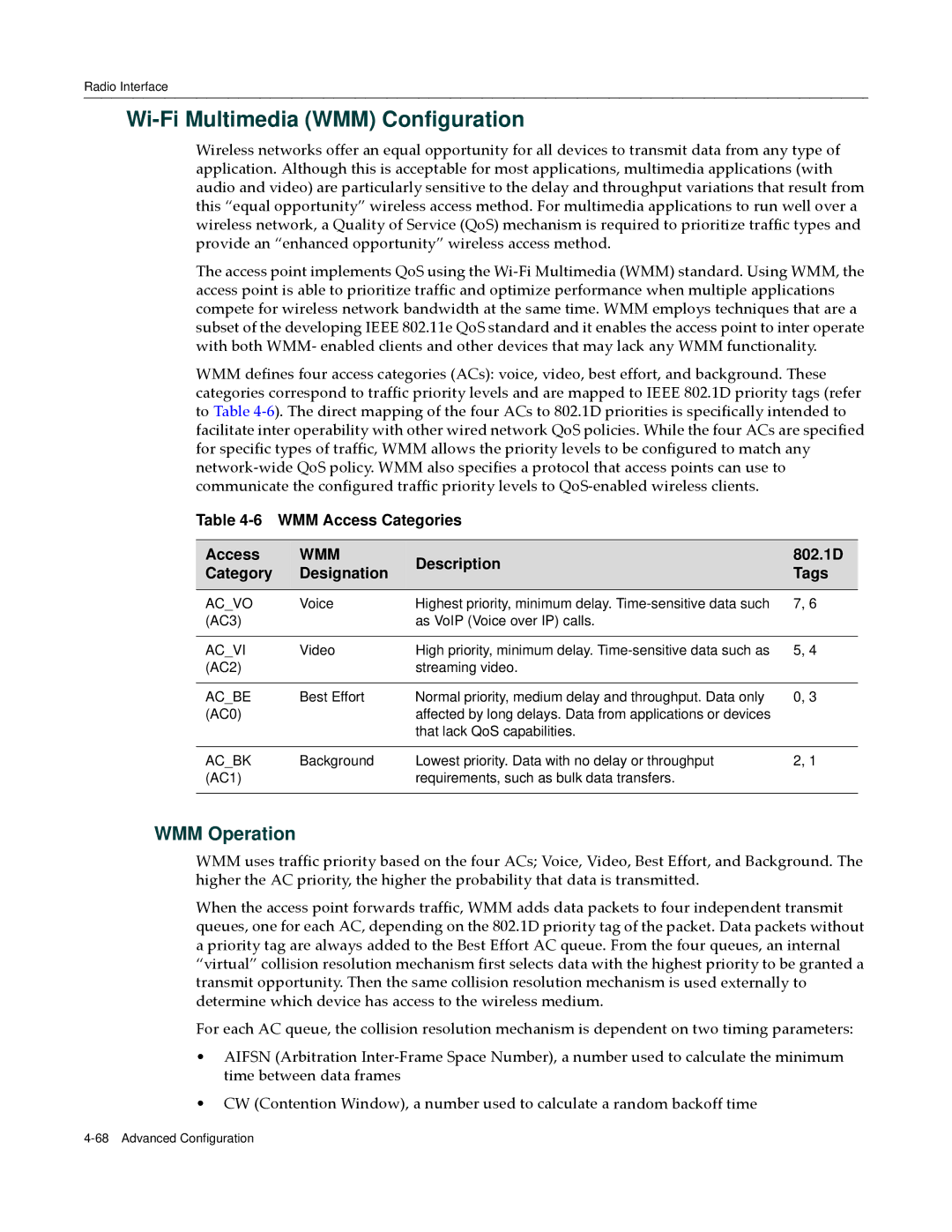Radio Interface
Wi-Fi Multimedia (WMM) Configuration
Wireless networks offer an equal opportunity for all devices to transmit data from any type of application. Although this is acceptable for most applications, multimedia applications (with audio and video) are particularly sensitive to the delay and throughput variations that result from this “equal opportunity” wireless access method. For multimedia applications to run well over a wireless network, a Quality of Service (QoS) mechanism is required to prioritize traffic types and provide an “enhanced opportunity” wireless access method.
The access point implements QoS using the Wi‐Fi Multimedia (WMM) standard. Using WMM, the access point is able to prioritize traffic and optimize performance when multiple applications compete for wireless network bandwidth at the same time. WMM employs techniques that are a subset of the developing IEEE 802.11e QoS standard and it enables the access point to inter operate with both WMM‐ enabled clients and other devices that may lack any WMM functionality.
WMM defines four access categories (ACs): voice, video, best effort, and background. These categories correspond to traffic priority levels and are mapped to IEEE 802.1D priority tags (refer to Table 4‐6). The direct mapping of the four ACs to 802.1D priorities is specifically intended to facilitate inter operability with other wired network QoS policies. While the four ACs are specified for specific types of traffic, WMM allows the priority levels to be configured to match any network‐wide QoS policy. WMM also specifies a protocol that access points can use to communicate the configured traffic priority levels to QoS‐enabled wireless clients.
Table
Access | WMM | Description | 802.1D | |
Category | Designation | Tags | ||
| ||||
|
|
|
| |
AC_VO | Voice | Highest priority, minimum delay. | 7, 6 | |
(AC3) |
| as VoIP (Voice over IP) calls. |
| |
|
|
|
| |
AC_VI | Video | High priority, minimum delay. | 5, 4 | |
(AC2) |
| streaming video. |
| |
|
|
|
| |
AC_BE | Best Effort | Normal priority, medium delay and throughput. Data only | 0, 3 | |
(AC0) |
| affected by long delays. Data from applications or devices |
| |
|
| that lack QoS capabilities. |
| |
|
|
|
| |
AC_BK | Background | Lowest priority. Data with no delay or throughput | 2, 1 | |
(AC1) |
| requirements, such as bulk data transfers. |
| |
|
|
|
|
WMM Operation
WMM uses traffic priority based on the four ACs; Voice, Video, Best Effort, and Background. The higher the AC priority, the higher the probability that data is transmitted.
When the access point forwards traffic, WMM adds data packets to four independent transmit queues, one for each AC, depending on the 802.1D priority tag of the packet. Data packets without a priority tag are always added to the Best Effort AC queue. From the four queues, an internal “virtual” collision resolution mechanism first selects data with the highest priority to be granted a transmit opportunity. Then the same collision resolution mechanism is used externally to determine which device has access to the wireless medium.
For each AC queue, the collision resolution mechanism is dependent on two timing parameters:
•AIFSN (Arbitration Inter‐Frame Space Number), a number used to calculate the minimum time between data frames
•CW (Contention Window), a number used to calculate a random backoff time
